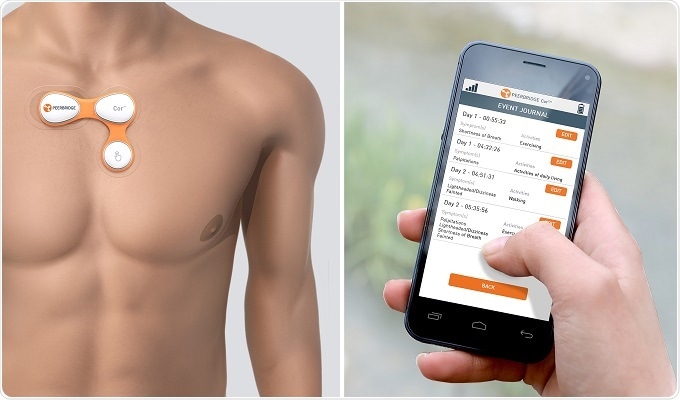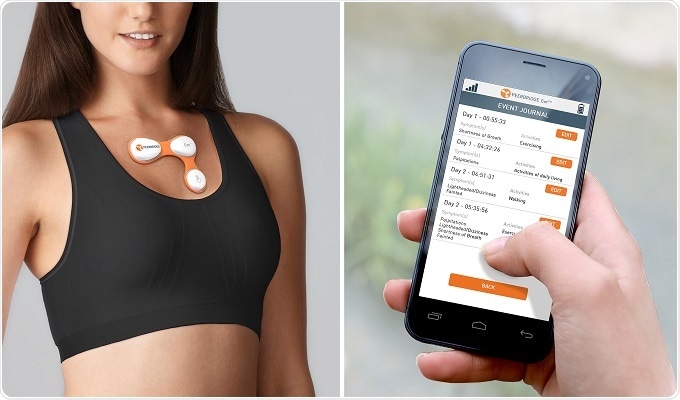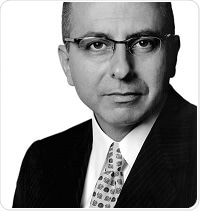An interview with Dr. Angelo Acquista, Founder of Peerbridge Health, conducted by April Cashin-Garbutt, MA (Cantab).
What is the vision behind Peerbridge Health?
Our vision is to remove all wires associated with monitoring patients. For example, typically, electrocardiogram (ECG) monitoring systems have a multitude of wires. We started building a wireless ECG monitoring system called the Peerbridge Cor™ to improve ECG monitoring from the ground up.
The vision came to me in 2004 when my father became ill and I had to spend three months in the Intensive Care Unit (ICU). During that time, I spent much of my day taking care of him. As a physician and Associate Chief of the ICU at Lenox Hill Hospital in New York City for 17 years, I knew all too well that ICU patients are essentially bedbound with wires tethered to them to monitor their vitals. This is what inspired the idea of a wireless monitoring system for all vitals.
At that time, there was no iPhone or smart devices, technology was not advanced enough to support wireless anything. After developing the concept for two years, in 2006, we submitted a patent application, which proved to be the beginning of six-year journey until we were awarded the patent in 2012. This is when we secured our first venture check and decided to start with wireless monitoring of the heart. The biggest difficulty with wireless ECG is monitoring multiple views of the heart from a very small physical footprint on the body. Traditional theory suggested that one must space leads far apart to achieve multiple ECG channels, as this is where wires are important. That is why today’s wireless monitors only provide a single channel of ECG, and therefore by in large does not satisfy many of the diagnostic needs of a cardiologist who’s simply trying to make an accurate arrhythmia diagnosis.

What are the benefits of a wireless system?
Two key issues associated with the many wires attached to patients is that they limit patients’ ability to be mobile and when they are asked to move their bowels and to urinate in bed, it turns an unsanitary situation for any monitoring device within firing range of those fluids increasing the risk of infection. Those wires are then wiped down and used on the next patient. With my father, I would carefully disconnect him from the wires and carry him to the bathroom. During this time, I did not know what his vital signs were. When I brought him back to bed, the nurses would then have to reconnect him. The process took about 10 minutes to disconnect and 10 more to reconnect. The gowns patients wear must also be removed to do this.
A further reason to lose the wires is for patient’s freedom and well-being. When a person feels wires, they have a sense of not feeling well, that they are constrained and so a wireless system makes it easier for individuals to get up and move, which gives them a sense of independence and well-being.
Can you please outline the wireless system Peerbridge Health developed?
Peerbridge Health is a remote monitoring company with a platform that has begun with multi-lead ECG and is expanding its pipeline to include other vitals.
We began with ECG monitoring for two reasons; one, heart disease is the leading cause of death in our country and it often can be prevented with proper monitoring, and two, a clear ECG is one of the most difficult vitals to continuously monitor. For a true heart monitor it must provide multiple channels of ECG to give physicians a clear understanding on how a heart is beating in a three-dimensional space. The challenge was that most industry experts said it was not possible to monitor multiple views of the heart from a device as small as what was proposed. We are excited to share that not only is it possible, but the Peerbridge Cor was found to provide significantly clearer ECG in a double blinded study against the wired Holter monitor that Northwell Health currently uses. The other vital signs we plan to monitor in the future are oxygen saturation, respiratory rate, temperature and blood pressure, which we will introduce through our expanded product line.

How does the technology differ from the traditional gold standard, the Holter?
The Peerbridge Cor is different from the Holter in that it is wireless, very small and delivers patient triggered events in real-time. It also produces better quality data, with reduced artefacts and less false positives. Evidence to support this was found in the Lenox Hill Hospital clinical trial, where patients were followed in an IRB supervised and independent trial.
In the double blind study, we had three certified ECG technicians review the ECG strips from the Peerbridge product and review the ECG strips from the Holter monitor. Even though the technitions were unaware of which strip came from which device, all three technicians reported significantly less artefact and fewer false positives from the Peerbridge Cor over the Holter monitor. This is because much of our product R&D focused on reducing noise from the user’s muscle movement and other outside interference.
By removing the wires and cancelling external noise, more analyzable data is able to be captured that can be used for diagnosis. Furthermore, it is not uncommon to experience loss of data due to artefact from wired devices, so physicians do not receive a full 24-hour of analyzable data.
Another way the Cor remote patient monitor is different from the others, that are now wireless, is that other products are single lead products, producing a single channel. The more channels you have, the more angles you have of viewing at the heart’s contractility, which provides physicians better information when diagnosing.
Can you please outline your recent partnership with Northwell Health?
We're very excited about our recent partnership with Northwell Heath. Not only do they share our vision for driving efficiency and better health outcomes through remote monitoring, but they also made a meaningful investment.
There is about 890,000[i] staffed hospital beds in the United States, where a small percentage are monitored. Studies have come out of Harvard that show if you increase the utilization of monitoring, patients experience less adverse events, translating to decreased length of stay. Frost and Sullivan estimates this increase in monitoring may reduce cost to up to $15 Billion[ii], annually.
Northwell has been a strong strategic partner, sharing our passion to bring effective digital solutions to consumers and health professionals with the highest medical standard.
What impact do you hope this agreement will have?
The goal of this partnership is to re-define the current medical standard for the monitoring of patients. Northwell Health shares this vision with us, and we plan to work towards consolidating other vital signs onto the platform in the future.
What do you think the future holds for wireless remote monitoring?
Going wireless is the future of healthcare.
As humans, we are built to move. Exercising and moving keeps us healthy and wires restrain this fundamental need. I envision a future where patients are given 2-3 different devices to purchase and keep at their home. These devices will sync with each other providing dynamic information on a regular basis. Patients will be encouraged to wear their sensors before and during medical consultations in addition to intermittently throughout their life to passively monitor key biomarkers.
What developments do Peerbridge Health have in the pipeline?
The goal is to begin as a diagnostic company, which is what we're doing now, and to extend into therapeutics.
We plan to expand from monitoring heart rate and heart rhythm to blood oxygen saturation, respiration, blood pressure and ultimately monitoring sleep to help support a patient’s course of holistic treatment.
These metrics allow doctors to know more about their patient because they have more context to how their body reacts to everyday life. Through artificial intelligence, we can analyze all of this and then give the doctors clinical decision support, a list of possible diagnoses and the therapies based on the patient's physiological functions.
How secure is this technology? Is patient data protected?
All the patient data is HIPAA compliant and that's part of the submission to the FDA. We had to make sure that everything followed the laws of HIPAA and that is part of their review. To go the extra mile, we have recently recruited the former Chief Information and Security Officer of AT&T to ensure our patient’s data is never compromised.
What other applications do you see for the Peerbridge product?
In the future, this Peerbridge product will be kept on and monitor sleep at night, so that we can study a patient’s sleep without them having to go to a facility. This is especially important because about twenty-three percent (23%) of people in America have sleep apnea. We have filed patents so that we can wirelessly monitor and then treat obstructive sleep apnea. By picking up sleep apnea and treating it with wireless electrodes that are embedded onto the skin, accessing the hypoglossal muscle and through wireless connection on a person’s chest, where we pick up decreased respiration, we can stimulate the hypoglossal muscle to stay in tone to prevent sleep apnea.
We have more than 200 components in this electrode system, the Peerbridge Cor, and it took us from 2013 to now, to get to the point where we are today, because we had to make this invention that did not yet exist. While we are starting out as a heart rate and rhythm monitoring system, we have big plans for the future and intend to do much more.
Where can readers find more information?
About Dr. Angelo Acquista
 Angelo Acquista, M.D., received his medical degree from the New York University School of Medicine and is affiliated with Lenox Hill Hospital in Manhattan as an attending physician and clinical instructor. He is board-certified in internal medicine, pulmonary medicine, and tropical diseases.
Angelo Acquista, M.D., received his medical degree from the New York University School of Medicine and is affiliated with Lenox Hill Hospital in Manhattan as an attending physician and clinical instructor. He is board-certified in internal medicine, pulmonary medicine, and tropical diseases.
He served as medical director for the New York City Office of Emergency Management and on Mayor Guiliani’s Task Force on Bioterrorism. He is the New York Times bestselling author of The Survival Guide: What to Do in a Biological, Chemical, or Nuclear Emergency. Outside of the field of medicine, Dr. Acquista has a passion for home cooking and published one of Amazon’s best-selling cookbooks, the Mediterranean Prescription. He lives in New York City.